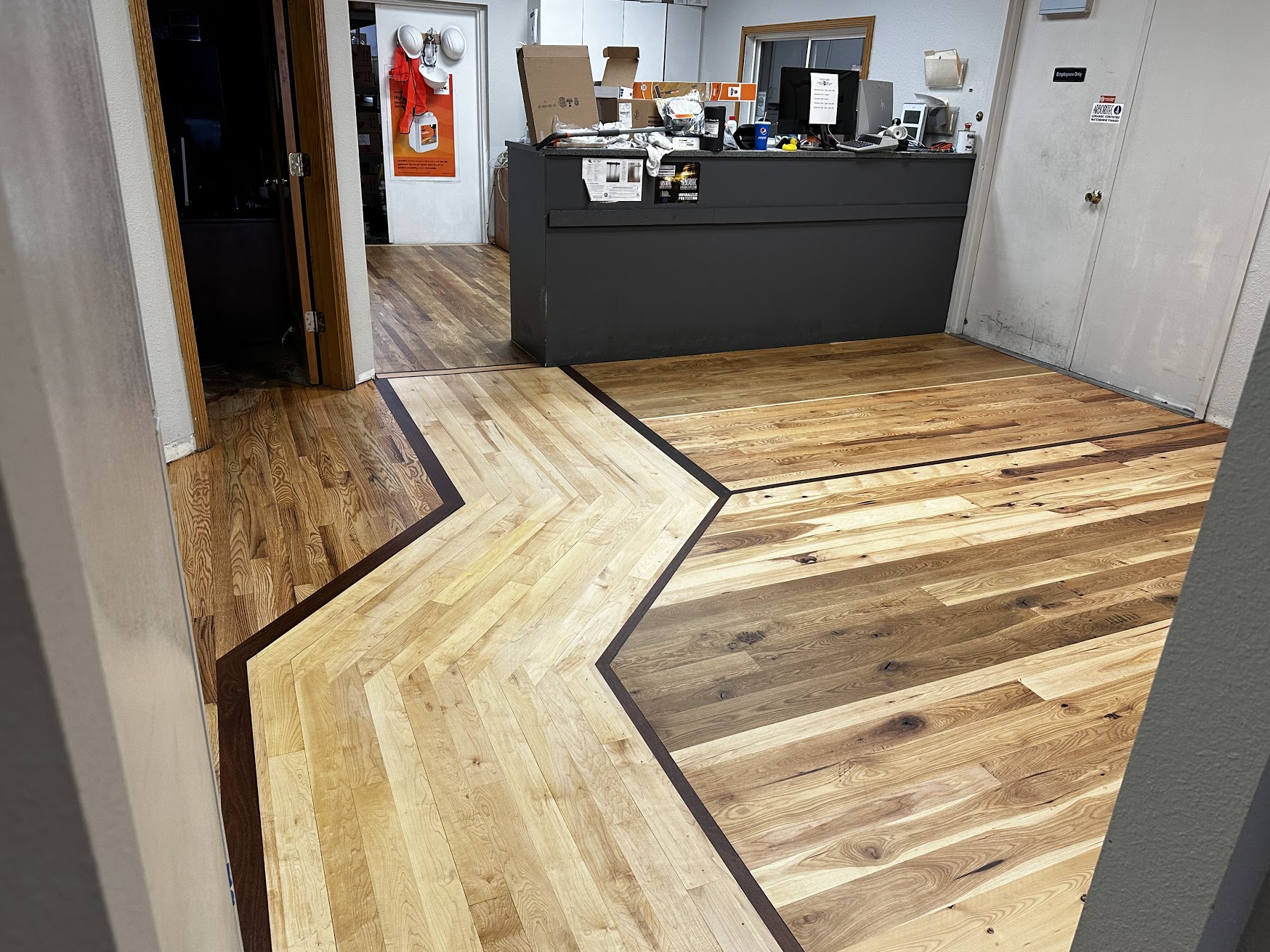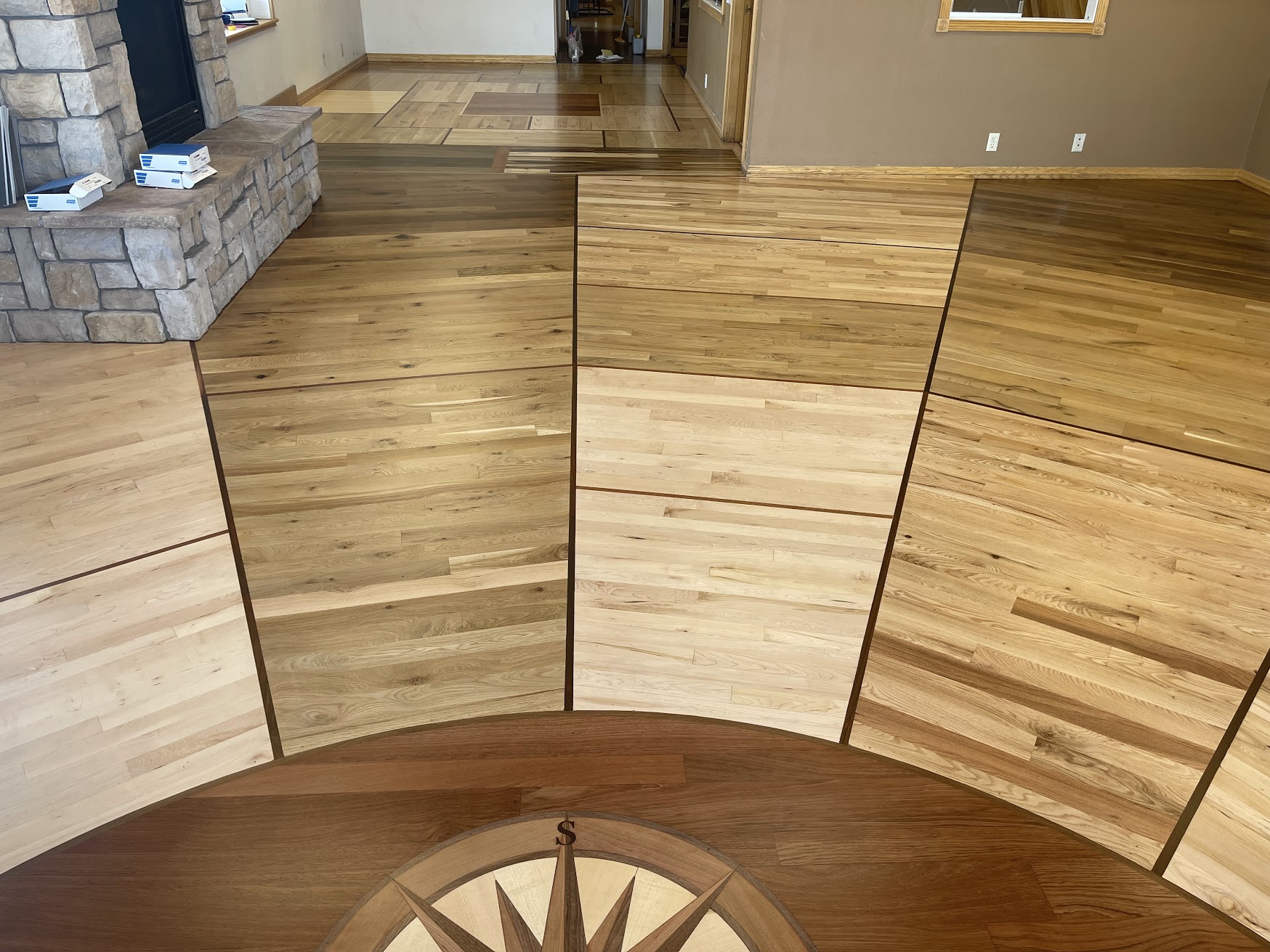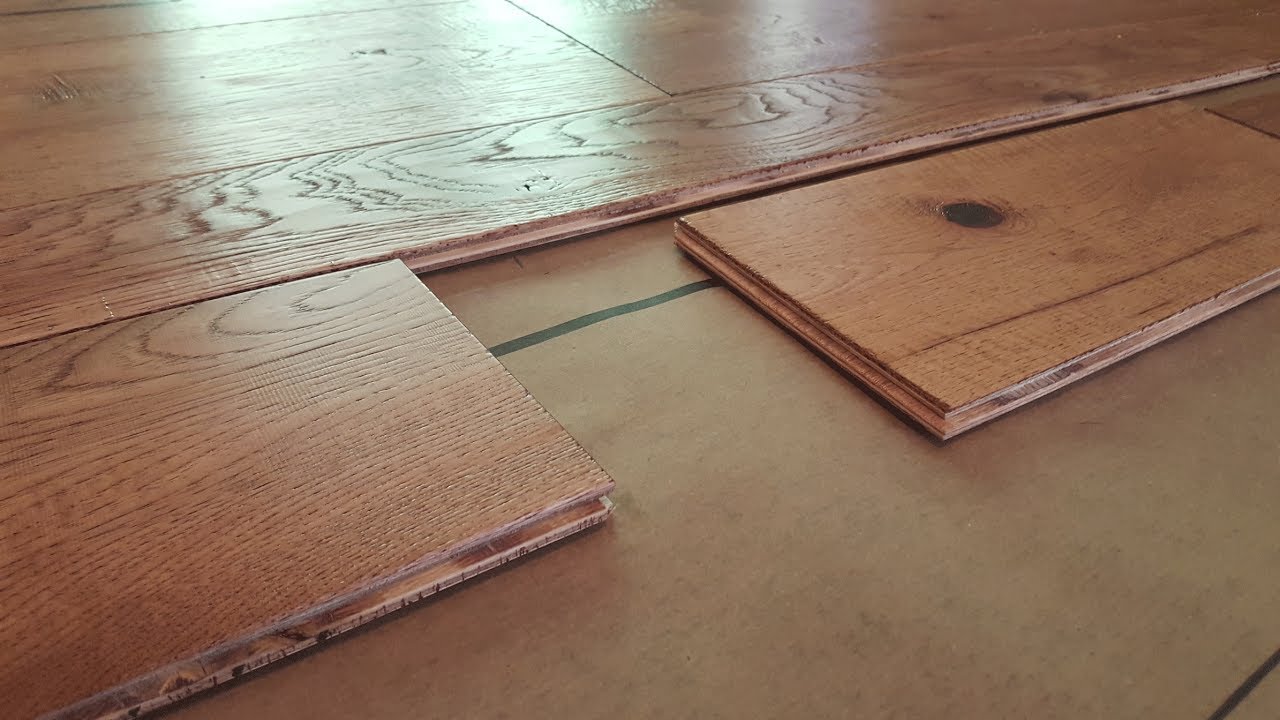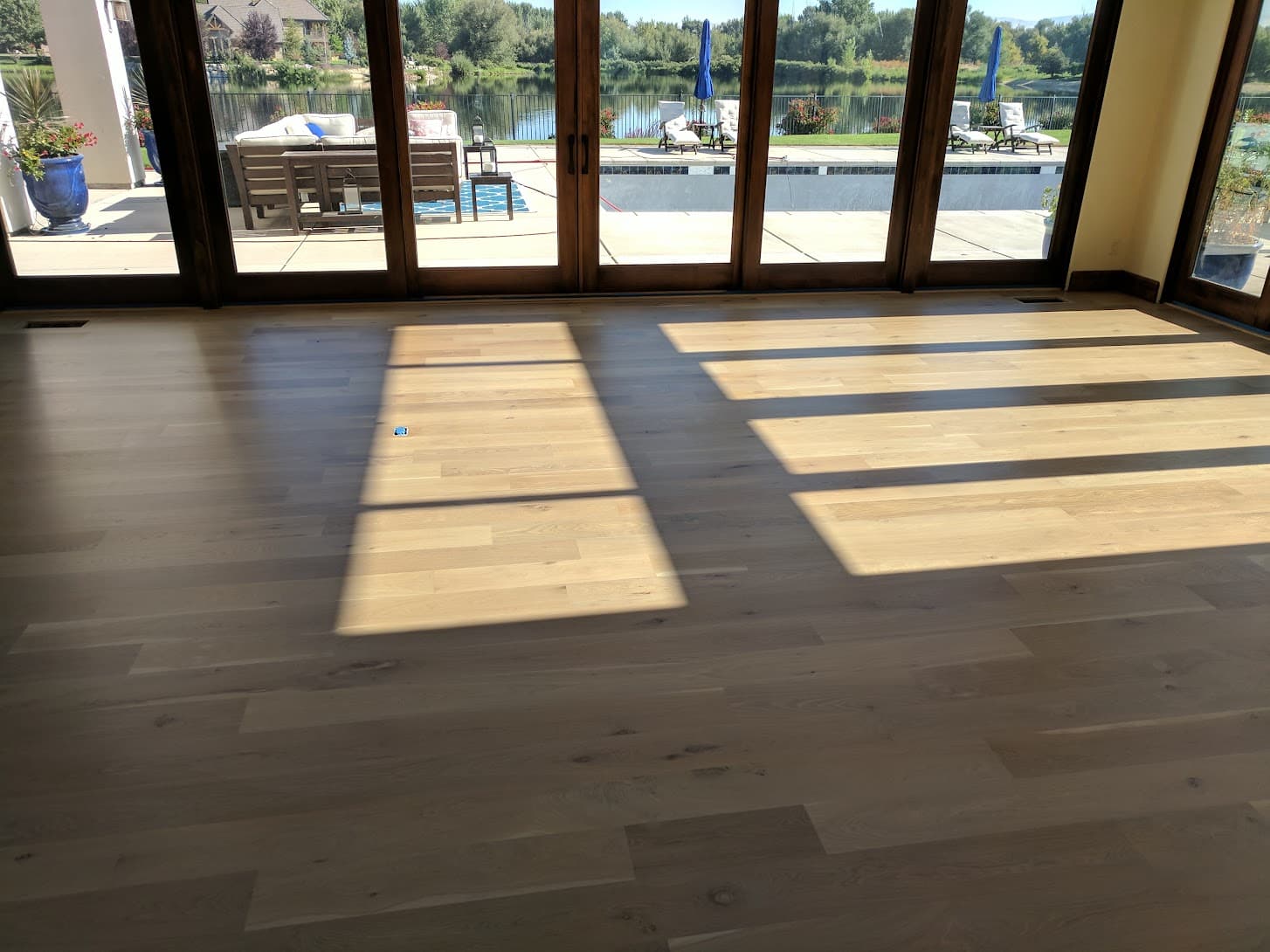The purpose of this article, “Hardwood Floor Installation: The Ultimate Guide,” is to provide a general overview of the process. Please note that it is not intended to cover every detail or address specific technical aspects of the installation. Instead, it is meant to give you a general understanding of the process and how to maintain your hardwood floors after the installation is complete. Your hardwood flooring professional will handle the more intricate details.
Overview of Hardwood Floor Installation in Spokane
Installing solid hardwood flooring involves a series of steps, including preparing the subfloor, laying a moisture barrier (if needed), installing the first row of planks along a straight edge, continuing to install the rest of the flooring by staggering the end joints and tapping the planks into place, trimming and installing the final row, and installing baseboards or quarter round molding to cover the expansion gap between the floor and the wall. While this can be a challenging project, the end result will add value and improve the appearance of your home. It is important to carefully follow the manufacturer’s instructions for the specific flooring product being used and to get some practice cutting and installing a few planks before beginning the main project.
Steps Before a Hardwood Floor Installation Can Start in Spokane
Choose a Wood
First things first are to decide which wood species would be right for you.
- Maple: Hard, dense wood with a tight grain pattern. Light color ranging from creamy white to light brown. Resistant to wear and a good choice for high-traffic areas.
- Hickory: Hard, dense wood with a pronounced grain pattern. Varied colors range from light to dark brown, with shades of red and gold. Highly durable and a good choice for high-traffic areas.
- White oak: Hard, dense wood with a medium to the coarse grain pattern. Light to medium brown color. Resistant to wear and a good choice for high-traffic areas.
- Red oak: Hard, dense wood with a medium grain pattern. Light to medium red-brown color. Resistant to wear and a good choice for high-traffic areas.
- Walnut: Hard, dense wood with a medium to the fine grain pattern. Rich, dark brown color. Unique grain pattern and natural beauty, but prone to denting if something is dropped on it.
Choose a Mill
While different mills may produce the same species of wood, they can vary in quality and efficiency. While the price of wood may be similar from one log to the next, the time and effort that a mill puts into preparing the wood can impact its overall value. Rustic Floro Supply offers wood from three different mills and is confident in the quality of each.
Hillsboro: Great strip mill that produces a wonderful product that typically is higher grade and better-looking wood. The milling is nearly perfect for a great installation that will last decades.
Ten oaks: Offers sealed hardwood to ensure less moisture transfers to the wood over time. This helps ensure the wood does not move during the seasons as much as other companies.
WD: A cheaper mill that is called a strip mill. They cover smaller widths but at an extremely cheap price. The wood is slightly lower on the grading schedule, but the price is amazing.
Are there Stairs?
Premade stairs offer several advantages over stairs that are built on-site. One of the main benefits is that they are glued together, which makes them more stable and durable. They are also cut and fit into place, which eliminates the need for sanding or other adjustments. This means that they can be installed quickly and finished on-site with minimal sanding. As a result, premade stairs tend to be flatter and more aesthetically pleasing than stairs that are built on-site.
Common Steps of a Hardwood Floor Installation
Sub Floor Preparation
Before you begin installing hardwood flooring, it is important to properly prepare the subfloor. Here are some general steps to follow to ensure that your subfloor is ready for hardwood flooring:
- Clean the subfloor: Remove any dirt, debris, or old flooring from the surface.
- Check for levelness: Use a level to ensure that the subfloor is even. If there are any uneven areas, use a self-leveling compound to smooth them out.
- Repair any damage: If the subfloor is damaged, repair it before installing the hardwood flooring. This may involve replacing damaged sections or filling in holes or cracks.
- Make sure the subfloor is dry: It is important to ensure that the subfloor is completely dry before installing the hardwood flooring. If the subfloor is damp, it could cause problems with the wood flooring.
- Buff any raised edges on the 4×8 sheets of plywood: If there are any edges on the plywood sheets that are raised or rough, buff them down to create a smooth surface.
Moisture Barrier
Moisture barriers are an important component of hardwood floor installations, particularly when the subfloor is concrete. Concrete can release moisture, which can damage wood flooring by causing it to expand and contract. This can lead to warping, cupping, and other issues.
To protect the wood from moisture, it is necessary to create a barrier between the concrete and the wood using a moisture barrier. This will help to prevent moisture-related problems with the flooring and increase its lifespan.
There are several types of moisture barriers available, including plastic sheeting, underlayment, and paint-on barriers. It is important to follow the manufacturer’s instructions for your specific flooring product and to choose the appropriate moisture barrier for your installation.
Proper Hardwood Floor Installation
To ensure that your hardwood floor is stable, durable, and looks good, it is important to follow proper installation procedures. Here are some general steps to follow:
- Install the first row of flooring: Begin by laying the first row of flooring along a straight edge, such as a wall or chalk line. This row should be straight and parallel to the wall. Secure it to the subfloor using a nail gun or adhesive.
- Continue installing the flooring: Once the first row is in place, continue installing the rest of the flooring. Make sure to stagger the end joints of the planks by at least 6 inches to create a more visually appealing and stable floor. Use a tapping block and hammer to tap the planks into place.
- Trim and install the final row: After all the planks are in place, you may need to trim the final row to fit. Use a jigsaw or circular saw to cut the planks to size. Then install the final row in the same way you installed the rest of the flooring.
What method of installation is Best for Hardwood Floor Installation?
Solid Hardwood
- Nails: Nails are often used to install solid hardwood flooring, which consists of a single piece of wood. They help to hold the planks in place and provide additional stability to the flooring. However, if the flooring is 5 inches or thicker, the National Wood Flooring Association (NWFA) recommends using glue in addition to nails to ensure that the flooring is secure.
- Subfloor type: The type of subfloor can also determine whether nails or glue are used to install the flooring. For example, if the subfloor is concrete, it may be necessary to use glue to hold the flooring in place. On the other hand, if the subfloor is plywood or another type of wood, nails may be sufficient.
Engineered Flooring:
For engineered hardwood flooring, it is generally recommended to use glue in combination with cleats or staples as fasteners. Glue helps to reduce the occurrence of cracks, squeaks, and other noise-related issues that can sometimes occur with engineered flooring. It is important to use glue with engineered hardwood to help ensure a stable, quiet floor.
Benefits of Having a Hardwood Floor Installed in Spokane, WA
There are many benefits to installing hardwood floors in a home. Hardwood floors are generally very durable and can last for many years with proper care. They are easy to keep clean, as they don’t trap dirt and dust like carpet does. Hardwood floors are also hypoallergenic, as they don’t harbor allergens such as pet dander, mold, and dust mites. In addition, hardwood floors have a natural beauty that can add warmth and character to a home. They are also versatile and can be stained and finished in a variety of colors and styles to match a wide range of decors. Installing hardwood floors can also increase the value of a home and are often preferred by buyers. While hardwood floors do have some drawbacks, such as cost and the need for regular maintenance, many people find that the benefits outweigh these drawbacks.
If you are considering installing hardwood floors, Rustic Floor Supply recommends finding a professional flooring contractor from their list of trusted installers. These installers use professional-grade products, are skilled in their craft, and offer excellent service at a competitive price.
Common Questions About Installation of Hardwood Flooring
Although the installation phase itself doesn’t typically generate dust, the removal of old flooring materials can. Even carpets can harbor a significant amount of dust and dirt. When carrying them outside, you’ll likely observe dust particles in the air. To minimize dust in areas where installation isn’t taking place, it’s advisable to use plastic barriers or coverings.
While DIY installation is possible for those with the right skills and tools, it’s often recommended to hire a professional to ensure a proper and long-lasting installation.
The best installation method depends on factors like the type of hardwood, the subfloor, and your preferences. Consult with a professional installer to determine the most suitable method for your specific situation.
Subfloor preparation includes ensuring it’s clean, level, and dry. Any imperfections should be addressed, and a moisture barrier may be necessary, especially over concrete.
Yes, you can install engineered hardwood floors over a concrete slab or in a basement because they are less prone to moisture-related issues compared to solid hardwood.
Yes, it’s essential to acclimate hardwood flooring to the room’s temperature and humidity for a specified period, usually around 3-7 days, to prevent expansion or contraction after installation.
Solid hardwood is typically nailed or stapled down, while engineered hardwood can be nailed, stapled, glued, or even floated, making it more versatile for various installation methods.
The installation time for hardwood floors varies based on the size of the area, the complexity of the job, and the type of installation. On average, it may take a few days to a week. Typically an installer does 300-500 sq ft a day depending on the width of the wood. This does not include the sanding portion.
Author Profile
- I have worked in hardwood flooring for the last 8 years. Use to run a company of residential crews as well as a company with gym flooring. If you need floor installation or refinishing help, I should have an answer or at least get you in the right direction.
Latest entries
 Hardwood FlooringJune 21, 2025How to Find FSC-Certified Wholesale Wood Flooring: Your Complete Guide
Hardwood FlooringJune 21, 2025How to Find FSC-Certified Wholesale Wood Flooring: Your Complete Guide Hardwood FlooringJune 18, 2025Wholesale vs. Retail Wood Flooring: What’s the Difference in Quality?
Hardwood FlooringJune 18, 2025Wholesale vs. Retail Wood Flooring: What’s the Difference in Quality? Hardwood FlooringJune 15, 2025Wholesale Wood Flooring for Contractors: What You Need to Know
Hardwood FlooringJune 15, 2025Wholesale Wood Flooring for Contractors: What You Need to Know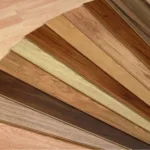 Hardwood FlooringJune 12, 2025The Best Types of Wood for Hardwood Floors
Hardwood FlooringJune 12, 2025The Best Types of Wood for Hardwood Floors

